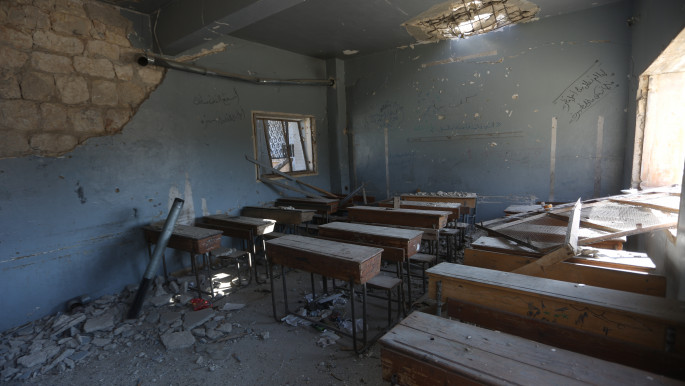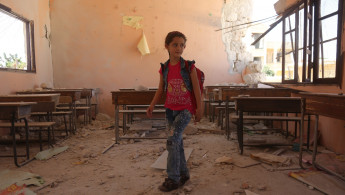Assad's assault on Idlib's schools
Salam returned to her village of al-Nayrab in the eastern Idlib province last week for the first time in months, expecting to reunite with classmates from her old school.
But nothing was left, just memories of smiles and laughter from the corridors and classrooms, now covered in rubble and debris.
Russian warplanes destroyed her school earlier this year during a military operation with the Syrian regime in Idlib province. The bloody campaign in 2019 and early 2020 killed hundreds of people and displaced over a million, before a ceasefire deal was reached in March.
At the beginning of 2020, Salam and nine family members were displaced from al-Nayrab to Salqin, next to the Turkish-Syrian border, during a campaign by Bashar al-Assad's forces to recapture Maarat al-Numan in January after two months of a punishing regime siege and daily bombings.
Salam, like many Syrian children in Idlib, was forced to abandon her studies as the newly displaced struggled to find schools, which had either been destroyed or were at full capacity.
 |
Idlib has witnessed a tragic academic year in every sense of the word |  |
The collapse of the Syrian pound and financial hardship meant that for many children, education was no longer an option. Salam's father Munir had lost his job during the military campaign after his supermarket in al-Nayrab was destroyed by artillery shells.
Having returned to her village, life in al-Nayrab has been completely transformed. Most of her old friends were displaced by regime attacks, and her new classmates are unfamiliar faces. Her home now lies in ruins, with the family staying temporarily at her uncle's house, who is himself still displaced in al-Dana, near the Turkish border. Despite life's difficulties, Salam still dreams of becoming a dentist. "School is a mother," she says.
 |
| A missile lies in a school yard in eastern Idlib [Ali Haj Suleiman] |
Idlib has witnessed a tragic academic year in every sense of the word, Mustafa Haj Ali, a media official in the province’s Education Directorate, told The New Arab.
Russian and regime forces deliberately targeted civilian infrastructure and schools during their military campaign earlier this year, he said, with tens of thousands displaced to refugee camps and border areas.
The directorate has been working tirelessly to set up education facilities for students displaced to new areas, but dozens of schools were destroyed in fighting, including institutions in Khan Sheikhoun, Maarat al-Numan, Kafr Nabl and the directorate's headquarters in Saraqeb.
 |
| Russian and regime forces deliberately targeted civilian infrastructure and schools during their military campaign earlier this year [Ali Haj Suleiman] |
The mass displacement of people to areas in northwestern Syria considered safer has made obtaining precise statistics about the number of students and teachers displaced, or killed, near impossible to quantify, Ali says.
Two further crises followed for education in Idlib. A European grant to support schools, which used to support nearly 65 percent of teachers and schools with a salary stipend, was stopped. Most teachers now work voluntarily without pay. The second, and most devastating, was the Covid-19 pandemic.
A meeting was held at the beginning of this academic year between education directorates and civil society institutions, along with health and civil defence organisations, to stress the urgent need to reopen schools to compensate for the previous year.
 |
Al-Nayrab had five schools, of which three were destroyed and one is in need of restoration after being struck by a missile |  |
Precautionary measures will be applied, including social distancing and masks and gloves for teachers and students. Families will only have to pay 10 Turkish liras ($1.20) for the academic year. A contingency plan for an outbreak of infection has also been created, whereby students will be tested, and school suspended until the results are confirmed.
The number of students is estimated at 210,000 for the current academic year, half the number of 2019, prior to the regime's military campaign. There are around 600 schools in operation, less than half the number of 1,400 reported in 2011.
 |
| New school facilities have been established by Idlib's Education Directorate in camps and areas hosting displaced persons [Ali Haj Suleiman] |
UNICEF reports that after nearly ten years of war more than one in three schools are no longer operational. Many have been damaged, destroyed or are used to shelter displaced families. Some schools have also been turned into military headquarters by regime forces.
New facilities, however, have been established by the Education Directorate in camps and areas hosting displaced persons, including in al-Dana, Sarmada, Maarat Misrin, Kelly and Hazano. Most of these areas have seen their population swell as new arrivals flee fighting in other areas. Al-Nayrab had five schools, of which three were destroyed and one is in need of restoration after being struck by a missile.
A number of volunteer teachers are also now working to implement distance learning in agreement with the Education Directorate to provide up to 40 percent of the curriculum on social media for all students, in case schools are closed again.
 |
| Idlib's Education Directorate has planned to provide up to 40 percent of the curriculum on social media, in case schools are closed again [Ali Haj Suleiman] |
Muhammad Hallaj, Director of the Syria Response Coordinators Team, says that nearly 80 schools in Idlib have become shelters for displaced families since 2015, with around 35 now providing education again.
In camps near the border sheltering displaced families there are around 45 schools with over 140,000 students, but children face multiple obstacles. Two out of every ten drop out for financial reasons, either to work or beg, while for many young girls marriages are arranged to provide support for their families.
Mohamad Karkas and Ali Haj Suleiman are photojournalists based in Idlib, Syria
Follow them on Twitter: @Mohamad_karkas @AliHajSuleiman



